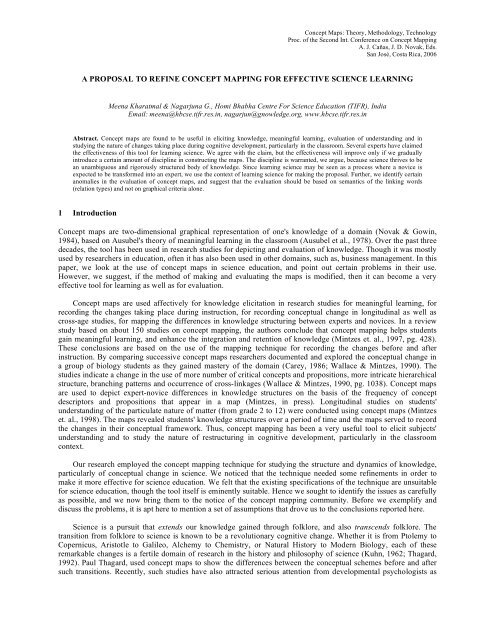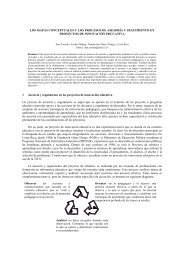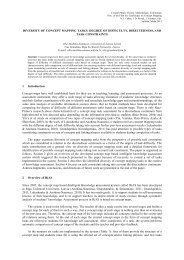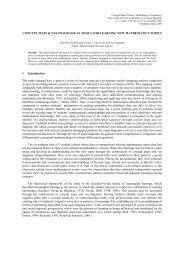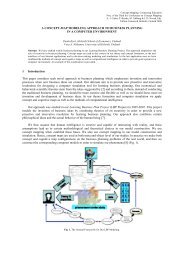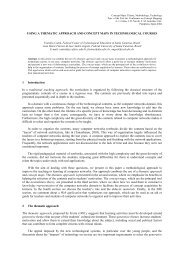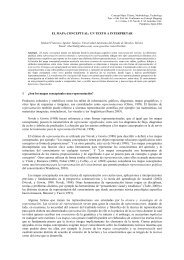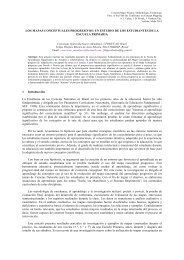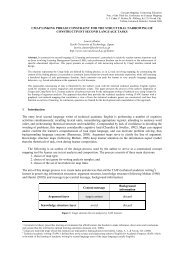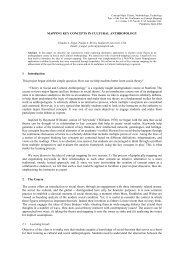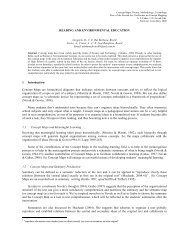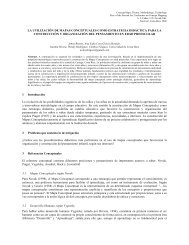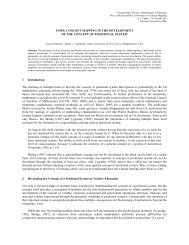A Proposal to Refine Concept Mapping for Effective Science Learning
A Proposal to Refine Concept Mapping for Effective Science Learning
A Proposal to Refine Concept Mapping for Effective Science Learning
Create successful ePaper yourself
Turn your PDF publications into a flip-book with our unique Google optimized e-Paper software.
<strong>Concept</strong> Maps: Theory, Methodology, Technology<br />
Proc. of the Second Int. Conference on <strong>Concept</strong> <strong>Mapping</strong><br />
A. J. Cañas, J. D. Novak, Eds.<br />
San José, Costa Rica, 2006<br />
A PROPOSAL TO REFINE CONCEPT MAPPING FOR EFFECTIVE SCIENCE LEARNING<br />
Meena Kharatmal & Nagarjuna G., Homi Bhabha Centre For <strong>Science</strong> Education (TIFR), India<br />
Email: meena@hbcse.tifr.res.in, nagarjun@gnowledge.org, www.hbcse.tifr.res.in<br />
Abstract. <strong>Concept</strong> maps are found <strong>to</strong> be useful in eliciting knowledge, meaningful learning, evaluation of understanding and in<br />
studying the nature of changes taking place during cognitive development, particularly in the classroom. Several experts have claimed<br />
the effectiveness of this <strong>to</strong>ol <strong>for</strong> learning science. We agree with the claim, but the effectiveness will improve only if we gradually<br />
introduce a certain amount of discipline in constructing the maps. The discipline is warranted, we argue, because science thrives <strong>to</strong> be<br />
an unambiguous and rigorously structured body of knowledge. Since learning science may be seen as a process where a novice is<br />
expected <strong>to</strong> be trans<strong>for</strong>med in<strong>to</strong> an expert, we use the context of learning science <strong>for</strong> making the proposal. Further, we identify certain<br />
anomalies in the evaluation of concept maps, and suggest that the evaluation should be based on semantics of the linking words<br />
(relation types) and not on graphical criteria alone.<br />
1 Introduction<br />
<strong>Concept</strong> maps are two-dimensional graphical representation of one's knowledge of a domain (Novak & Gowin,<br />
1984), based on Ausubel's theory of meaningful learning in the classroom (Ausubel et al., 1978). Over the past three<br />
decades, the <strong>to</strong>ol has been used in research studies <strong>for</strong> depicting and evaluation of knowledge. Though it was mostly<br />
used by researchers in education, often it has also been used in other domains, such as, business management. In this<br />
paper, we look at the use of concept maps in science education, and point out certain problems in their use.<br />
However, we suggest, if the method of making and evaluating the maps is modified, then it can become a very<br />
effective <strong>to</strong>ol <strong>for</strong> learning as well as <strong>for</strong> evaluation.<br />
<strong>Concept</strong> maps are used affectively <strong>for</strong> knowledge elicitation in research studies <strong>for</strong> meaningful learning, <strong>for</strong><br />
recording the changes taking place during instruction, <strong>for</strong> recording conceptual change in longitudinal as well as<br />
cross-age studies, <strong>for</strong> mapping the differences in knowledge structuring between experts and novices. In a review<br />
study based on about 150 studies on concept mapping, the authors conclude that concept mapping helps students<br />
gain meaningful learning, and enhance the integration and retention of knowledge (Mintzes et. al., 1997, pg. 428).<br />
These conclusions are based on the use of the mapping technique <strong>for</strong> recording the changes be<strong>for</strong>e and after<br />
instruction. By comparing successive concept maps researchers documented and explored the conceptual change in<br />
a group of biology students as they gained mastery of the domain (Carey, 1986; Wallace & Mintzes, 1990). The<br />
studies indicate a change in the use of more number of critical concepts and propositions, more intricate hierarchical<br />
structure, branching patterns and occurrence of cross-linkages (Wallace & Mintzes, 1990, pg. 1038). <strong>Concept</strong> maps<br />
are used <strong>to</strong> depict expert-novice differences in knowledge structures on the basis of the frequency of concept<br />
descrip<strong>to</strong>rs and propositions that appear in a map (Mintzes, in press). Longitudinal studies on students'<br />
understanding of the particulate nature of matter (from grade 2 <strong>to</strong> 12) were conducted using concept maps (Mintzes<br />
et. al., 1998). The maps revealed students' knowledge structures over a period of time and the maps served <strong>to</strong> record<br />
the changes in their conceptual framework. Thus, concept mapping has been a very useful <strong>to</strong>ol <strong>to</strong> elicit subjects'<br />
understanding and <strong>to</strong> study the nature of restructuring in cognitive development, particularly in the classroom<br />
context.<br />
Our research employed the concept mapping technique <strong>for</strong> studying the structure and dynamics of knowledge,<br />
particularly of conceptual change in science. We noticed that the technique needed some refinements in order <strong>to</strong><br />
make it more effective <strong>for</strong> science education. We felt that the existing specifications of the technique are unsuitable<br />
<strong>for</strong> science education, though the <strong>to</strong>ol itself is eminently suitable. Hence we sought <strong>to</strong> identify the issues as carefully<br />
as possible, and we now bring them <strong>to</strong> the notice of the concept mapping community. Be<strong>for</strong>e we exemplify and<br />
discuss the problems, it is apt here <strong>to</strong> mention a set of assumptions that drove us <strong>to</strong> the conclusions reported here.<br />
<strong>Science</strong> is a pursuit that extends our knowledge gained through folklore, and also transcends folklore. The<br />
transition from folklore <strong>to</strong> science is known <strong>to</strong> be a revolutionary cognitive change. Whether it is from P<strong>to</strong>lemy <strong>to</strong><br />
Copernicus, Aris<strong>to</strong>tle <strong>to</strong> Galileo, Alchemy <strong>to</strong> Chemistry, or Natural His<strong>to</strong>ry <strong>to</strong> Modern Biology, each of these<br />
remarkable changes is a fertile domain of research in the his<strong>to</strong>ry and philosophy of science (Kuhn, 1962; Thagard,<br />
1992). Paul Thagard, used concept maps <strong>to</strong> show the differences between the conceptual schemes be<strong>for</strong>e and after<br />
such transitions. Recently, such studies have also attracted serious attention from developmental psychologists as
well as educationists (Carey, 1986; Nersessian, 1998; Vosniadou & Ioannides, 1998). The nature and dynamics of<br />
these transitions are still an active area of research, and obtaining at this stage a unitary picture of this discourse is<br />
very difficult. However, there are a few characteristics that distinguish the knowledge representation be<strong>for</strong>e and after<br />
such transitions. Since these characteristics have a bearing on the discussion that follows, we state them briefly here.<br />
Folklore, though not devoid of abstractions, is less abstract than scientific knowledge. Folklore depends on<br />
implicit meaning gained mostly by use, while the terms used in scientific language thrive <strong>to</strong> gain their meaning from<br />
explicit definitions, mostly by operational definitions. Folklore <strong>to</strong>lerates ambiguous usage of terms, while scientific<br />
terms being well defined are least ambiguous. Scientific language also tends <strong>to</strong> be parsimonious. The objective of<br />
this paper is not <strong>to</strong> argue in favor of these assumptions, we proceed assuming their validity (Nagarjuna, working<br />
paper). If we assume that science tends <strong>to</strong> be the least ambiguous and the most explicit body of knowledge, then we<br />
expect that during science education when students are undergoing a cognitive transition from folk language <strong>to</strong><br />
scientific language, there occurs a process of redefining and re-representing knowledge structures. If we assume that<br />
the objective of science education is <strong>to</strong> help in this restructuring, then we need <strong>to</strong> identify some methodological<br />
principles that will drive such a transition. Though we agree that the fuller context of the transition from folklore <strong>to</strong><br />
science is <strong>to</strong>o complex, we can at least begin <strong>to</strong> identify some of the principles. Based on these, we can suggest<br />
some refinements in concept mapping methodology. The objective of this paper is <strong>to</strong> point out some refinements<br />
based on the assumptions outlined above.<br />
The strategy is <strong>to</strong> take few examples of concept maps from the literature, and point out the problems in their<br />
evaluation. There<strong>for</strong>e we will be conducting the discussion centered around the scoring of the maps and in the<br />
process identify the problems. Traditionally, concept maps are evaluated <strong>for</strong> structural complexity and propositional<br />
validity. While scoring the concept maps, various elements – concepts, propositions, hierarchy, branching, crosslinks<br />
– are assigned scores. The Novakian scoring model is the most widely used (Novak & Gowin, 1984, pg. 37)<br />
<strong>for</strong> evaluating concept maps, though some researchers have further modified the Novakian scoring rubric (Arnaudin<br />
et. al., 1984; Markham et. al., 1994; Wallace & Mintzes, 1990). According <strong>to</strong> the modified rubric, each proposition<br />
represented in a map is assigned a score of 1 if the concepts are linked via the linking words. Each level in a<br />
hierarchy is given a higher score of 5, because it represents subsumption, and a branch is assigned a score of 1 point<br />
<strong>for</strong> the first branch and 3 points <strong>for</strong> the successive branches, because it represents progressive differentiation. Crosslinks<br />
showing valid relationships between two distinct segments of the map are assigned the highest score of 10<br />
points, because it represents integrative reconciliation. Examples are assigned a score of 1 if these are used via the<br />
linking word `e.g.' and are placed at the terminal end of the concept map. In<strong>for</strong>med readers will realize that<br />
according <strong>to</strong> Ausubel, meaningful learning occurs in the <strong>for</strong>m of subsumption, progressive differentiation and<br />
integrative reconciliation (Ausubel et. al., 1978). These measures do capture the nature of knowledge structures,<br />
however, we shall show how this measure is insufficient <strong>for</strong> a comprehensive appraisal of the cognitive restructuring<br />
that happens in the context of learning science.<br />
In what follows, we begin by identifying how the existing rubric is inefficient in capturing and comparing the<br />
knowledge structures of novices and experts. In the process we also propose refinements, so that concept mapping<br />
can be used as an efficient <strong>to</strong>ol <strong>for</strong> teaching, learning and assessment.<br />
2 Problems in Measuring Cognitive Restructuring During <strong>Learning</strong><br />
A comment on the style of presentation in this section is relevant here. We shall take concept maps drawn by a<br />
student S1 and compare them with those drawn by S2 who is closer <strong>to</strong> the knowledge structure of an expert. The<br />
maps of S1 are shown on the left and the maps of S2 on the right. The concept maps were redrawn using CmapTools<br />
developed at IHMC (IHMC CmapTools, 2004). All maps marked S1 are taken from published literature duly cited.
Figure 1. <strong>Concept</strong> maps on sharks drawn by S1 and S2.<br />
2.1 Accuracy of linking words<br />
Consider the concept maps on sharks (Thompson & Mintzes, 2002) as shown in Figure 1. To indicate the problems<br />
related <strong>to</strong> linking words we have taken the map on the left side from published literature and redrew, and the right<br />
side one is made by us. If we use the Novakian scoring method the map drawn by S1 gets a higher score since, the<br />
number of nodes (concepts), and the number of propositions are more than in the map by S2. The map of S1 uses the<br />
linking phrase “can be” ambiguously: it is used <strong>to</strong> represent an inclusion relation, and also <strong>for</strong> possible attributes.<br />
The linking phrase “have” is also used ambiguously. The map of S2 is clearly more accurate, and says everything<br />
that the map S1 does. This example, illustrates the problem with the rubric, since the map of S2 is closer <strong>to</strong> an<br />
expert, but scores less than the novice's.<br />
Figure 2. <strong>Concept</strong> maps on living things drawn by S1 and S2.<br />
In a concept map on water (Novak & Gowin, 1984, pg. 16), shown here as a part of the map, the propositions<br />
about living things are depicted as shown in Figure 2. The concept map of S1 is problematic. The map represents<br />
correct knowledge, but uses incorrect linking words <strong>for</strong> the first two propositions. If we grant the map of S1 <strong>for</strong> the<br />
first two relations, S1 and S2 will get the same score. The concept map S1 depicts all propositions by the same<br />
linking word `e.g.' represents a `class-subclass' as well as `class-instance' relation. In the Novakian concept mapping<br />
methodology, learners are encouraged <strong>to</strong> anchor examples <strong>to</strong> the more specific concepts at the terminal end of the<br />
concept map by using the linking word `e.g.' (Novak & Gowin, 1984, pg. 16). Example represents the instance of<br />
the class, or <strong>to</strong>ken of a type. It is very important <strong>to</strong> realize that this relation is not of subtyping. The relation<br />
'instance-of' is an intransitive relation, whereas the relation `class-subclass' or subtyping is a transitive relation. It
may be noted that the usage of the linking word `e.g.' in the first proposition is imprecise because the actual relation<br />
between the concepts should be either `includes', or `subclass-of' or `subtype-of'. The second and third propositions<br />
depicts the class-instance relation and hence the linking word `e.g.' is appropriate. This usage is possible only after<br />
restructuring due <strong>to</strong> training. Should not we find a way of giving additional score <strong>for</strong> such an accurate and explicit<br />
use of the linking words displaying more mature representation<br />
To cite another instance from a concept map on sharks (Thompson & Mintzes, 2002) S1 has a proposition<br />
, and . S2's map has a proposition and . Both the maps of S1 and S2 according <strong>to</strong> traditional scoring<br />
method get equal score. But S2 deserves an extra score because the linking word `includes', and `consists of' depict a<br />
mature understanding. The map of S2 carefully distinguishes between the two kinds of inclusion relations (classsubclass<br />
and part-whole). Shouldn't we take care of this subtle restructuring that could have happened in S2<br />
The above examples illustrate that when a novice is becoming an expert, the same domain knowledge gets rerepresented<br />
by more accurate linking words. There<strong>for</strong>e it is necessary <strong>to</strong> distinguish such a structure from that of a<br />
novice, and we should find a way of providing additional score <strong>for</strong> maps made by S2.<br />
2.2 Validating Hierarchies<br />
Hierarchical organization of knowledge has been appraised as one of the distinguishing characters of scientific<br />
knowledge since the time of Pla<strong>to</strong> and Aris<strong>to</strong>tle. Ausubel's theory accommodates <strong>for</strong> it nicely under subsumption.<br />
We strongly agree with Novak that meaningful learning proceeds most easily when new concepts or concept<br />
meanings are subsumed under broader concepts. More inclusive concepts, should be at the <strong>to</strong>p of the map, with<br />
progressively more specific, less inclusive concepts arranged below them. Though, theoretically the points were well<br />
taken, in the practice of concept mapping we found some serious anomalies.<br />
The concept map on life in the ocean (Martin et. al., 2000) as shown in Figure 3 by S1 depicts hierarchy using<br />
the linking words: 'consists of', 'have 2 groups', 'are either' and 'include'. Based on the traditional scoring model each<br />
level of hierarchy is scored <strong>for</strong> 5 points and there appears 6 levels in the above hierarchy and so gets 30 points. The<br />
Novakian criteria <strong>to</strong> assign score <strong>for</strong> hierarchy is based on graphical and not semantic criteria. Logically, in a well<strong>for</strong>med<br />
hierarchy the relation must use a transitive, asymmetric, and a single linking word consistently. In S1's map<br />
the first relation takes part in part-whole relation and all the others in the hierarchy take part in class-subclass<br />
relation, though S1 uses different linking words. There<strong>for</strong>e, Novakian rubric fails <strong>to</strong> make this subtle distinction and<br />
commits a logical fallacy. This is a serious anomaly, and there<strong>for</strong>e we should find an appropriate refinement in<br />
validating hierarchies in the maps.
Figure 3. <strong>Concept</strong> maps on life in the ocean drawn by S1 and S2.<br />
3 Discussion<br />
Based on the examples that were considered above, we think, there is a need <strong>to</strong> attend <strong>to</strong> the problems, which can be<br />
handled properly by the concept mapping methodology, so that the restructuring will happen while extending the<br />
folk language <strong>to</strong> scientific language. Most of the problems can be resolved by focusing on the problem of choosing<br />
the right kind of linking words. Ambiguity in linking phrases and lack of rigor in concept mapping is already<br />
reported by other researchers (Costa et al., 2004). In the Artificial Intelligence (AI) community concept maps are<br />
considered as non-rigorous in methodology (Kremer, 1995; Sowa, 1984; Sowa, 2006), and the maps lack in<br />
Knowledge Representation (KR) <strong>for</strong>malisms (Cañas & Carvalho, 2004). This point of critique is cited in the works<br />
of Cañas, et. al. (2004) from IHMC <strong>to</strong> show that concept maps and AI (or KR) are not compatible.<br />
Despite the fact that there is freedom in selecting linking words, and though it gives an unlimited expressive<br />
power, it gives rise <strong>to</strong> ambiguity in concept maps. Most often the linking words used, are borrowed from the natural<br />
language, and may lead <strong>to</strong> ambiguity. The purpose of concept maps <strong>to</strong> help in meaningful learning is not achieved<br />
when the resulting concept maps are ambiguous and lead <strong>to</strong> vague understanding. While acknowledging that<br />
students begin with a rich tapestry of folk language, when they begin <strong>to</strong> learn science they are required <strong>to</strong> weed out<br />
expressions. The requirement by the AI community <strong>to</strong> weed out ambiguity is somewhat related <strong>to</strong> this, since<br />
computing systems cannot handle implicit knowledge. Similarly, scientific language strives <strong>to</strong> be as explicit as<br />
possible. If we recall what happened in each of the great scientific revolutions, we will realize that so much ef<strong>for</strong>t<br />
was spent by the masters, such as Galileo, in conceptual cleansing. In fact it was argued that revolutionary changes<br />
<strong>to</strong>ok place due <strong>to</strong> change in conceptual schemes (see the case studies in Nagarjuna, 1994). There<strong>for</strong>e, we think that<br />
during the process of learning science, we need <strong>to</strong> create an opportunity <strong>to</strong> restructure the concept maps drawn while<br />
learning in any domain so that the students reach as close <strong>to</strong> the expert's knowledge structure as possible.<br />
If our line of thinking is valid, then the task is <strong>to</strong> identify an operational way of bringing modifications <strong>to</strong> the<br />
concept mapping methodology. Having already identified that the main problem is with respect <strong>to</strong> the linking words,
let us focus on what we can do here. Though we may think that there can be innumerable number of linking words,<br />
if we look closely in<strong>to</strong> any expert domain in any science, we realize that the number of kinds of linking words is<br />
limited, and does not increase as the knowledge advances. Let us call the kinds of linking words as relation types.<br />
Take any large concept map of any domain, and take a measure of the number of relation types used <strong>to</strong> re-represent<br />
the knowledge. We hypothesize that the number reaches very quickly a constant figure <strong>for</strong> each domain of<br />
knowledge and does not increase any further. Our hypothesis has already some support from the preliminary<br />
evidences of Fisher's work. A biology network created by a team revealed 67 relations used <strong>to</strong> link about 2,300<br />
concepts (Fisher, 1990, pg. 1003). Our ongoing research further substantiates our hypothesis, and we will report the<br />
results on another occasion. In a study conducted by us, a chapter from the Class VIII science textbook was rerepresented<br />
as a concept map by carefully choosing accurate relation types. We found that the entire knowledge of<br />
the chapter needed only 6 relation types in a network of about 70 propositions (Kharatmal, 2006). If our argument<br />
that experts tend <strong>to</strong> use less number of relation types has any weight, then while using concept mapping technique in<br />
science education we should make a special ef<strong>for</strong>t <strong>to</strong> inculcate discipline in choosing the right kind of relation types.<br />
It may not be inappropriate <strong>to</strong> give a higher score <strong>for</strong> choosing the right kind of relation type while making the<br />
maps. If accurate use of relation type is a good index of expertize and restructuring of knowledge, every valid<br />
relation type should be given a higher score. We are not proposing a specific value <strong>for</strong> the score yet, and may be<br />
decided by experts in knowledge mensuration. Our purpose is <strong>to</strong> initiate a discussion.<br />
Figure 4. <strong>Concept</strong> maps on living organisms drawn by S1 and S2.<br />
By taking care of appropriate relation types, the problem reported above on the hierarchy also gets resolved.<br />
Consider the maps drawn in Figure 4. By the traditional method the map drawn by S1 has three levels of hierarchy.<br />
However, the same map is re-represented by us as S2 using our proposed discipline. We see two distinctly valid<br />
hierarchies, one <strong>for</strong> the relation type 'consists of' which has two levels, and the other using the relation type 'includes'<br />
which has three levels. Clearly the <strong>for</strong>mer one is a hierarchy of part-whole relation, and the latter is of class-subclass<br />
relation. This rigor, we think, is necessary <strong>for</strong> science education, and reflects the restructuring that takes place while<br />
becoming an expert.<br />
In this paper we have identified certain anomalies in the existing concept mapping and scoring methodology,<br />
particularly keeping in mind the use of concept mapping <strong>for</strong> science education. We have attempted <strong>to</strong> show that the<br />
traditional rubric is inefficient in capturing and comparing the knowledge restructuring during the transition from the<br />
novice <strong>to</strong> an expert. We have proposed that if concept mapping methodology is refined by attending <strong>to</strong> the problems<br />
and by following a few suggestions made in this paper, it can become a more effective <strong>to</strong>ol in studying the structure<br />
and dynamics of knowledge.<br />
4 References<br />
Ausubel, D., Novak, J., and Hanesian, H. (1978). Educational Psychology: A Cognitive View. New York: Holt,<br />
Rinehart and Wins<strong>to</strong>n.<br />
Arnaudin, M. A., Mintzes, J. J., Dunn, C. S., & Shafer, T. H. (1984). <strong>Concept</strong> mapping in college science teaching.<br />
Journal of College <strong>Science</strong> Teaching, 117—121.
Cañas, A. J., & Carvalho, M. (2004). <strong>Concept</strong> Maps and AI: an Unlikely Marriage In Proceedings of SBIE 2004:<br />
Simpósio Brasileiro de In<strong>for</strong>mática Educativa. Manaus, Brasil: SBC.<br />
Carey, S. (1986). <strong>Concept</strong>ual change and science education. American Psychologist, 41(10), 1123--1130.<br />
Costa, J. V., Rocha, F. E., & Favero, E. L. (2004). Linking phrases in concept maps: A study on the nature of<br />
inclusivity. In A. J. Canas, J. D. Novak, & F. M. Gonzalez (Eds.), <strong>Concept</strong> Maps: Theory, Methodology,<br />
Technology. Universidad Publica de Navarra, Pampalona, Spain.<br />
Fisher, K. (1990). Semantic networking: The new kid on the block. Journal of Research in <strong>Science</strong> Teaching,<br />
27(10), 1001--1018.<br />
IHMC CmapTools (2004). The Website of CmapTools. http://cmap.ihmc.us.<br />
Kharatmal, M. (2006). <strong>Concept</strong> map on cell structure and function. At IHMC Public Cmaps \ Meena (India) \ Cell<br />
Structure and Function \ Cell Structure and Function.<br />
http://skat.ihmc.us/servlet/SBReadResourceServletrid=1139090479160_113084903_8482&partName=htmlte<br />
xt<br />
Kremer, R. (1995). The design of a concept mapping environment <strong>for</strong> knowledge acquisition and knowledge<br />
representation. Proceedings of the 9th International Knowledge Acquisition Workshop.<br />
Kuhn, T. (1962) The Structure of Scientific Revolutions. USA: University of Chicago Press.<br />
Markham, K. M., Mintzes, J. J. & Jones, M. G. (1994). The concept map as a research and evaluation <strong>to</strong>ol: Further<br />
evidence of validity. Journal of Research in <strong>Science</strong> Teaching, 31(1), 91—101.<br />
Martin B. L., Mintzes, J. J., & Clavijo, I. E. (2000). Restructuring knowledge in biology: Cognitive processes and<br />
metacognitive reflections. International Journal of <strong>Science</strong> Education, 22(3), 303-323.<br />
Mintzes, J. J. (In Press). Knowledge restructuring in biology: Testing a punctuated model of conceptual change.<br />
International Journal of <strong>Science</strong> and Mathematics Education.<br />
Mintzes, J. J., Wandersee, J., & Novak, J., (Eds.). (1998). Teaching <strong>Science</strong> <strong>for</strong> Understanding --- A Human<br />
Consctructivist View. USA: Academic Press.<br />
Mintzes, J. J., Wandersee, J. H., & Novak, J. D. (1997). Meaningful <strong>Learning</strong> in <strong>Science</strong>: The Human Constructivist<br />
Perspective. In Gary D. Phye (Ed.), Handbook of Academic <strong>Learning</strong>: Construction of Knowledge (pp. 405-<br />
47). USA: Academic Press.<br />
Nersessian, N. J. (1998). <strong>Concept</strong>ual change. In W. Bechtel, & G. Graham (Eds.), A Companion <strong>to</strong> Cognitive<br />
<strong>Science</strong>. Blackwell, Malden, MA. 155-166.<br />
Nagarjuna, G. (working paper). From Folklore <strong>to</strong> <strong>Science</strong>. Paper presented at the Eighth International His<strong>to</strong>ry,<br />
Philosophy, Sociology & <strong>Science</strong> Teaching Conference, Leeds, UK, July 15-18, 2005.<br />
Nagarjuna, G. (1994). The Role of Inversion in the Genesis, Development and the Structure of Scientific<br />
Knowledge. Ph.D. Thesis, Department of Humanities and Social <strong>Science</strong>s, Indian Institute of Technology,<br />
Kanpur, India. http://cogprints.org/4340/<br />
Novak, J. D., & Gowin, D. B. (1984). <strong>Learning</strong> How <strong>to</strong> Learn. New York: Cambridge University Press.<br />
Sowa, J. (2006). <strong>Concept</strong> mapping. Talk presented at the AERA Conference, San Francisco.<br />
http://www.jfsowa.com/talks/cmapping.pdf<br />
Sowa, J. (1984). <strong>Concept</strong>ual Structures: In<strong>for</strong>mation Processing in Mind and Machine. USA: Addison-Wesley<br />
Publishing Company.<br />
Thagard, P. (1992). <strong>Concept</strong>ual Revolutions. USA: Prince<strong>to</strong>n University Press.<br />
Thompson, T. L., & Mintzes, J. J. (2002). Cognitive structure and the affective domain: On knowledge and feeling<br />
in biology. International Journal of <strong>Science</strong> Education, 24(6), 645-600.<br />
Vosniadou, S. & Ioannides, C. (1998). From conceptual development <strong>to</strong> science education: A psychological point of<br />
view. International Journal of <strong>Science</strong> Education, 20(10), 1213-1230.<br />
Wallace, J. D., & Mintzes, J. J. (1990). The concept map as a research <strong>to</strong>ol: Exploring conceptual change in biology.<br />
Journal of Research in <strong>Science</strong> Teaching, 27(10), 1033--1052.


